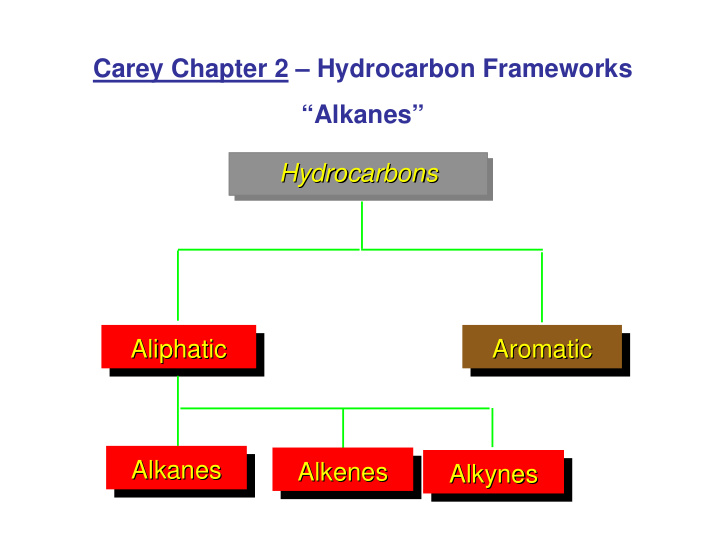



Carey Chapter 2 – Hydrocarbon Frameworks “Alkanes” Hydrocarbons Hydrocarbons Hydrocarbons Aliphatic Aromatic Aliphatic Aromatic Aliphatic Aromatic Alkanes Alkanes Alkenes Alkenes Alkynes Alkynes Alkanes Alkenes Alkynes
2.2-2.3 Chemical Bonding Figure 2.3 – Valence bond picture for H 2
2.2-2.3 Chemical Bonding – Two Possibilities Figure 2.5
2.4 Molecular orbitals by combining two atomic orbitals Figure 2.6
2.5 Introduction to Alkanes – Methane, Ethane, Propane Figure 2.7 CH 4 CH 3 CH 3 CH 3 CH 2 CH 3 b.p. -160 o C -89 o C -42 o C
2.6 sp 3 Hybridization and bonding in Methane Figure 2.9
2.6 sp 3 Hybridization and bonding in Methane Figure 2.10
2.7 sp 3 Hybridization and bonding in Ethane Figure 2.11
2.8 Isomeric alkanes – the Butanes Structural Isomers C 4 H 10 n -butane C 4 H 10 isobutane 2.9-2.10 Higher alkanes – the C 5 H 12 isomers C 5 H 12 C 5 H 12 C 5 H 12 n -pentane isopentane neopentane
2.10 Higher alkanes – diversity
Careful with drawing chains! CH 3 CHCH 2 CH 3 CH 3 CH 2 CHCH 3 CH 3 CH 3 CH 3 CH 3 CHCH 2 CH 3 CH 3 CH 3 CH 2 CH 2 CH 3 CH 3 CH 2 CHCH 3 CH 3 All the same compound
2.11-2.12 Alkane nomenclature Need to know up to C-12
2.11-2.12 Alkane nomenclature IUPAC Rules: • Find the longest continuous carbon chain • Identify substituent groups attached to the chain • Number the chain so as to keep numbers small • Write the name in the following format: Numerical location - [substituent(s)][parent alkane] e.g. 2,3-dimethylheptane
2.12 IUPAC Rules and how to apply them Hexane (IUPAC); n -hexane (common) Longest chain - hexane substituent - meth yl position on chain - 2 2-methylhexane not 5-methylhexane 3,4-dimethylheptane
2.13 Alkyl groups Replace -ane ending with -yl H C C C C C C C C H H C primary (1 o ) secondary (2 o ) tertiary (3 o ) CH 3 H H H CH 3 H C C C CH H 3 C C CH 3 H H H CH 3 (CH 3 ) 3 C CH 3 CH 2 CH 2 (CH 3 ) 2 CH propyl group isopropyl group t -Butyl group 1-methylethyl 1,1-dimethylethyl
2.14 Highly branched alkanes 4-ethyloctane 4-ethyl-3-methyloctane 4-ethyl-3,5-dimethyloctane
2.15 Cycloalkanes 1,1,3-trimethylcyclohexane 2-ethyl-1,1- dimethylcyclopentane C(CH 3 ) 3 (notice the “di” is not (1,1-dimethylethyl)cycloheptane involved in the alphabetization)
2.16 Sources of alkanes and cycloalkanes Figure 2.12
2.17 Physical properties Figure 2.15
2.17 Physical properties – branched alkanes Figure 2.16
2.18 Chemical properties of Alkanes Alkane properties : • Generally very insoluble in water (“greasy” or “oily”) • Individual molecules interact via van der Waals forces • These intermolecular forces decrease with branching • Alkanes may be combusted in oxygen: CO 2 + 2H 2 O ∆ H = - 213 kcal e.g. CH 4 + 2O 2 i.e combustion of hydrocarbons releases energy
2.18 Heats of combustion – Figure 2.17
2.19 Oxidation-Reduction in Organic Chemistry
2.20 sp 2 Hybridization in ethylene Figure 2.18 H H C C H H
2.20 sp 2 Hybridization in ethylene Figure 2.19
2.20 sp 2 Hybridization in ethylene Figure 2.20
2.21 sp Hybridization in ethylene Figure 2.21
2.21 sp Hybridization in acetylene Figure 2.22
2.21 sp Hybridization in acetylene Figure 2.23
Recommend
More recommend